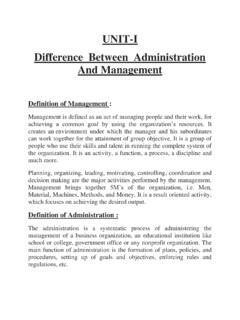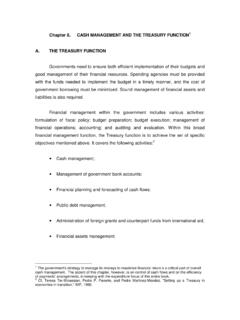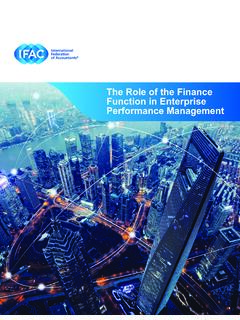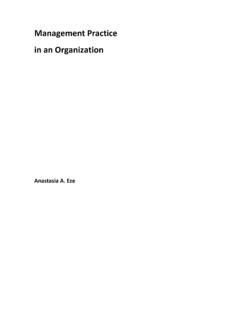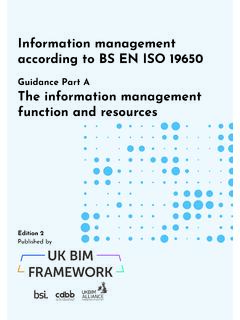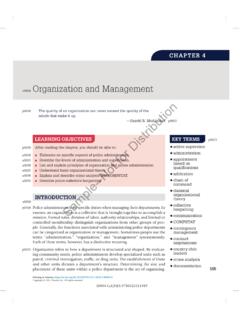Transcription of Legal Risk Management A heightened focus for the …
1 Legal Risk Management A heightened focus for the General CounselLegal Entity Management | Beyond complianceLegal Risk Management | A heightened focus for the General CounselForeword 3 What is Legal risk? 5 Accountability 6 Assess and control 8 Monitor and report 11 Technology 12 Interaction with regulators 14In 15 Contact 17 Contents2 Legal Risk Management | A heightened focus for the General CounselForewordCompanies, their boards and General Counsels (GCs) face a constantly evolving landscape with exposure to financial and reputational losses if Legal risks develop. This has created an expectation that in-house Legal teams will do more to identify, manage and mitigate the Legal risks in their organizations. In the financial services sector, there is increased regulatory interest, particularly looking at how Legal fits into the wider organizational risk framework.
2 These combined pressures are causing organizations to identify and manage more effectively the overlaps and gaps between Legal and the business (including other functions ).GCs are re-evaluating their operating models as discussed in our paper Optimizing your organization s in-house Legal operating model. In-house Legal teams are also making greater use of technology, both enterprise-wide systems and Legal -specific ones, which we explored in What s Your Problem? Legal Technology. As the Legal function transforms, so does the way in which it contributes to the organization s risk Management , playing a greater and more proactive role than has historically been the case. This has resulted in more explicit consideration of what constitutes Legal risk, how it should be managed and by point of view looks at the key considerations in approaching Legal risk Management and examines the steps being taken in getting to grips with Legal risk Management .
3 As part of our research, we surveyed a large number of businesses in multiple sectors to compare and contrast their relative maturity levels*, and provide our view of what the future holds in relation to the Management of Legal Fernando Guerra Global Leader, Deloitte Legallegallegalprotectliablefinancialfin ancialriskproceedingsfailurereputational losslossrightsactionsfinesfinesregulator ydamagesdamagesenforcementstatutorymeasu relegalcontractualcontractuallawlawinade quatebreachbreachnon-contractualobligati onslitigationlitigationpenalties* See page 18 for more information about our survey and Risk ManagementLegal Risk Management | A heightened focus for the General CounselWhat is the definition of Legal risk?What does good Legal risk monitoring and reporting look like?What interaction is there with regulators around Legal risk/ Legal risk Management ?
4 How can technology enable better Legal risk Management ?What organizational structure and skills are needed to ensure appropriate Management of Legal risk?Who in the organization is primarily accountable for Legal risk Management ?4 Legal Risk Management | A heightened focus for the General CounselMind-set changeLegal risk Management as a discipline is a relatively new way of thinking for many in-house Legal teams. The growing expectation in the financial services industry from other departments and regulators is that Legal gets explicitly involved in formal risk Management processes. When defining Legal risk which has been framed as reputational impact, operating or financial losses and issues affecting the organization s ability to do business it is clear that Legal needs to do more than the day job to identify, manage and mitigate Legal narrow or broad definition?
5 Some organizations apply a narrow definition in which Legal risks are solely those arising from Legal s operations such as resourcing decisions (in-house provision versus use of law firms), the quality of the advice provided by Legal and the conduct of its lawyers. Such a definition fails to take account of the many other risks that an organization faces which have a Legal component, for example financial crime, conduct and Legal risks arising from an organization s operations ranging from contractual to intellectual property disputes. The underlying activities may be owned by other parts of the business. Yet to deny some Legal function responsibility for managing the Legal risk inherent in those activities doesn t make sense and could result in responsibilities falling through the gap between Legal and the business.
6 Hence, many organizations apply a broad definition of Legal risk which encompasses any risk faced by the business which has a Legal component. Surprisingly, our surveys found that there are still a number of organizations 41% of non-banking and 14% of banking respondents with no definition of Legal risk. Where a definition was in place, this still varied widely in definition and focus , reflecting the lack of a Legal industry standard definition for Legal separate riskIn the past, GCs and organizations have often not considered Legal risk as a category in its own right and it has been subsumed within other risks rather than being explicitly identified in risk Management frameworks managed by Operational Risk, Compliance or Internal Audit. This may have been the case for financial services because Basel II defined Legal risk as being a part of operational risk.
7 Another reason for this lack of identification of Legal risk in its own right could be because of its comparative lower profile when compared to other risks arising from financial crime, conduct and duty of care, IT and cyber security which can have a much larger impact on the viability or capital adequacy of an organization . However, the level of fines for many businesses over recent years has driven significant changes in the profile of Legal risk in those organizations and peer group more importance than definition is identifying the risks , Legal and otherwise, that the organization faces and establishing an effective framework for their Management so that responsibility can be allocated between Legal , other functional areas and the Deloitte, we have developed a Legal risk taxonomy to help both in-house Legal functions and those responsible for the organization s risk Management system to better understand the Legal risk landscape.
8 The key risk areas we have identified encompass both narrow components owned by the Legal function; and broad ones such as contractual, intellectual property, legislative changes and Legal advice into other risk areas such as financial crime, conduct, employment and technology. It is clear from this that understanding Legal risk is as much about understanding the organization s rights and obligations as it is about understanding the letter of the , our surveys found that there are still a number of organizations 41% of non-banking and 14% of banking respondents with no definition of Legal is Legal risk?5 Legal Risk Management | A heightened focus for the General CounselOn a narrow definition of Legal risk, it is clear that the GC and the Legal function are accountable for identifying and managing those risks which arise from Legal s operations.
9 In the three lines of defense model, a commonly used risk Management framework across the survey participants (70%), the Legal function is the first line and others (typically Risk and Compliance) need to fill a second line role in relation to these risks . However, the consensus is that a broader definition of Legal risk should get more focus from the Legal function. Every operation and function of an organization runs risks which need to be controlled or avoided. Many of those risks have a Legal component. Legal needs to work across the organization to identify those Legal risks , set the appetite for each risk and agree the roles and responsibilities for Legal risk Management including accountability and the controls or other mitigation measures to implement. GCs and risk specialists will need to collaborate to develop an effective framework that captures the multitude of Legal risks that exist in organizations and design controls to mitigate the most owns the risk?
10 Ownership of risk will be determined by the structure of the organization and where the expertise sits to manage it. On a broader definition, business Management own Legal risk (including the GC in respect of Legal operational risk) and Legal and other functions provide support and advice. Where business functions have first line responsibility for Legal risk Management , Legal s role is to establish policies, raise awareness, advise and monitor the effectiveness of controls and mitigations. Legal needs to educate business Management so that they are better able to manage Legal risk what to do, what not to do and the implications if specific Legal risks are not properly implicationsIn multinational corporations, there is a significant coordination and horizon-scanning role for Legal . Across the organization s geographical footprint, Legal needs to understand the Legal risks arising in each country and how some risks may cross borders, potentially creating a double or multiple exposure if the risk materialises.










